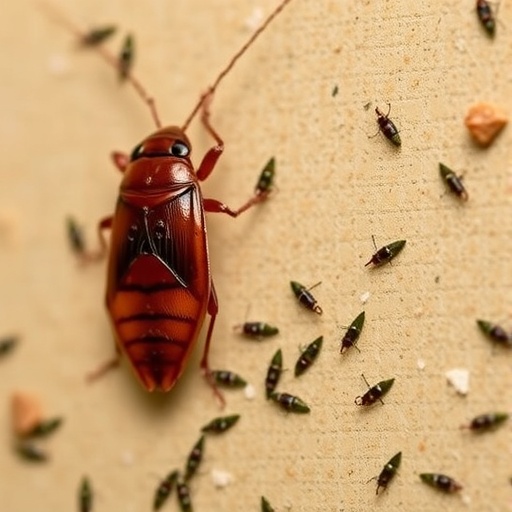A recent groundbreaking study conducted by researchers at North Carolina State University has unveiled a compelling connection between household cockroach infestations and elevated levels of allergens and endotoxins, posing significant implications for indoor environmental health. This pioneering research elucidates how targeted pest control interventions can markedly reduce these harmful substances, thereby offering new avenues for mitigating health risks in urban homes.
Endotoxins, components derived from the outer membrane of Gram-negative bacteria, are released during bacterial cell death and are known to incite immune responses upon inhalation. Cockroaches, notorious for their adaptability and omnivorous diets, harbor diverse gut microbiomes rich in these bacteria, making them prolific sources of endotoxins. The study highlights that fecal matter from cockroaches, particularly females, is a major vector for shedding endotoxins into the living environment, significantly contributing to the endotoxin load found in household dust.
The investigative team leveraged a comprehensive experimental approach, combining laboratory assays and real-world monitoring within multi-unit apartment complexes in Raleigh, North Carolina. They meticulously quantified the cockroach population within individual homes and measured corresponding concentrations of the cockroach allergen Bla g 2 alongside endotoxin levels in settled dust, airborne particulates, and HVAC filtration systems. Such multi-faceted sampling provided a robust dataset that captured both chronic and acute exposure scenarios.
A critical insight emerged from the sex-based differential in endotoxin excretion: female German cockroaches were found to excrete approximately twice the amount of endotoxins as their male counterparts. This disparity is attributed to the females’ higher food consumption, resulting in greater microbial biomass within their gastrointestinal tract, which in turn leads to increased endotoxin shedding through feces. Notably, kitchens exhibited higher endotoxin concentrations than bedrooms, aligning with cockroach habitat preferences tied to food availability.
To determine causality, researchers implemented an environmental intervention targeting cockroach elimination in a subset of infested homes. This pest control regimen led to a pronounced decline not only in cockroach numbers but also in both Bla g 2 allergen and endotoxin levels across multiple sampling points over a six-month period. Contrastingly, homes that received no intervention maintained persistently high levels of these contaminants, underscoring the direct role of cockroach presence in fostering an unhealthy indoor milieu.
The study further revealed that the allergenic proteins and endotoxins related to cockroaches are not confined to physical dust deposits but can become airborne, facilitating respiratory exposure. This airborne dispersion raises concerns about the potential for exacerbating allergic reactions and asthma symptoms, particularly among vulnerable populations residing in low-income urban environments where infestations tend to be more prevalent.
Professor Coby Schal, a leading entomologist and co-corresponding author of the study, emphasized the clinical significance by noting “small decreases in cockroach populations do not translate into proportional reductions in allergen levels, as surviving cockroaches continue to deposit allergens aggressively. Complete extermination is essential to achieve meaningful reductions.” This finding clarifies previous ambiguities in the literature regarding partial pest control effectiveness and reinforces the urgency of comprehensive pest management strategies.
The epidemiological context of the findings is equally compelling. Previous surveys have documented higher endotoxin concentrations in homes reporting cockroach presence, with a disproportionately higher burden in socioeconomically disadvantaged households. The current study builds on this foundation by establishing a mechanistic link that underscores cockroach feces as a primary conduit for endotoxin dissemination rather than attributing these bacterial components solely to other domestic sources such as pets or human occupants.
Looking forward, Schal and his team intend to delve deeper into the complex interplay between endotoxins and cockroach allergens through animal models, particularly focusing on asthma pathogenesis. Understanding how co-exposure to these substances influences inflammatory pathways and airway hyperresponsiveness could inform the development of targeted therapeutics and public health interventions aimed at reducing asthma morbidity among children in affected communities.
This research is a milestone in environmental health science, providing compelling evidence that effective cockroach control not only mitigates allergen burdens but also significantly lowers endotoxin exposure. Such dual reduction offers promising prospects for alleviating respiratory health disparities linked to poor housing conditions.
Moreover, the study highlights the importance of integrating microbiological assessments into urban housing health evaluations. Traditional pest management programs may now benefit from incorporating endotoxin monitoring to better gauge intervention success and health impact, aligning pest control more closely with public health objectives.
Funding for this multifaceted study involved an array of federal and institutional sources, reflecting a broad recognition of the health implications tied to indoor environmental quality. By merging expertise across entomology, microbiology, and clinical immunology, the research team has forged new paths that bridge basic biological insights with tangible, real-world health improvements.
In summary, the North Carolina State University study provides compelling, technical evidence of how cockroaches exacerbate indoor exposure to allergens and endotoxins, particularly spotlighting the outsized role of female cockroaches in this process. The research underscores the necessity of comprehensive extermination strategies in urban, low-income households to curtail these exposures and ultimately improve respiratory health outcomes.
Subject of Research: Animals
Article Title: Indoor Allergens and Endotoxins in Relation to Cockroach Infestations in Low-Income Urban Homes
News Publication Date: October 23, 2025
Web References:
DOI: 10.1016/j.jacig.2025.100571
Image Credits: Photo courtesy of Matt Bertone, NC State University.
Keywords: Cockroach infestation, endotoxins, allergens, Bla g 2, asthma, indoor air quality, urban health, pest control, German cockroach, environmental health, microbial exposure, respiratory disease




